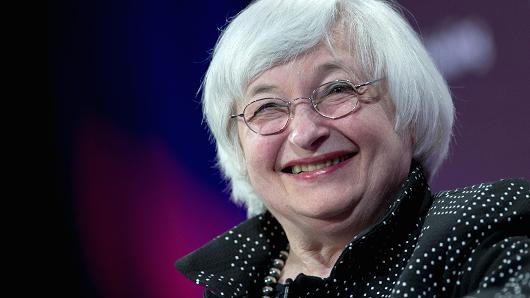Workers in December got their biggest raise since the recession ended in 2009, the clearest signal yet that if the Fed’s job of jump-starting the economy isn’t completely finished, the end is getting pretty close.
Fed Chair Janet Yellen and her central bank cohorts have bemoaned the lack of wage growth even as the headline unemployment rate has tumbled from a high of 10 percent back in October 2009 all the way down to 4.7 percent last month.
The pattern of 2 percent or so gains through most of the recovery has kept the Fed rooted to its policy of bargain-basement interest rates and, until late-2014, injecting trillions of dollars worth of liquidity into the financial system.
With a seemingly significant breakthrough in wages came talk Friday that it’s time to get interest rates back to normal. That was despite payrolls growth of just 156,000 that fell below market expectations for 178,000.
The wage move is “the final piece of evidence to conclude the labor market has recovered, mission accomplished, giving them the green light to accelerate interest rate increases,” said Scott Clemons, chief investment strategist at Brown Brothers Harriman.
“It’s also a data point that is to some degree divorced from the political rhetoric,” he added. “So much of the talk is, what are the implications of (President-elect Donald) Trump tax policy, immigration policy? This is a real-life indicator that the underlying trends regardless of politics are heading in the right direction. So this is an unequivocal positive both for the economy and the markets.”
How the Fed reacts to that, however, is unclear.
Federal Open Market Committee members, upon approving the first rate hike in a year last month, indicated that three more are on the way in 2017. But the market remains unconvinced. Even considering Friday’s jobs report, the only real reaction in the fed funds futures market was to price in a little higher probability of the next rate hike coming in June, and to indicate that one more might happen in November but was more likely in December.
However, futures expectations are notoriously volatile, and continued wage pressure, as well as Trump following through on expansionary fiscal policy promises, will change the market’s collective mind in a hurry.
“If we get a big dose of fiscal stimulus, whether it’s on the tax or spending side, I think the Fed is going raise rates more than expected,” David Wessel, senior fellow at the Brookings Institution, told CNBC. “We’re at near-full employment. The Fed is taking its foot off the gas pedal. If the Congress or the president put their foot down on the gas pedal, the Fed is going to have to pull it off more rapidly.”
Increasingly, Fed officials have been expressing similar concerns about letting pressure build in the labor market. At the December meeting, members worried that letting the unemployment rate fall too far could force the FOMC to raise rates more quickly than it had anticipated, which could lead to market disruptions.
If conditions are right, the Fed could well be forced into four hikes this year, said Paul Ashworth, chief U.S. economist at Capital Economics.
“With wage growth climbing again and price inflation set to rise well above 2 percent, the modest drop-off in employment growth won’t stop the Fed from tightening monetary policy more aggressively this year,” Ashworth said in a note to clients Friday.
However, it could be a little too soon to start unfurling that “mission accomplished” banner.
After all, labor force participation remains mired at lows not seen since the late 1970s, with more than 95 million Americans not in the labor force. Despite the wage gains, job creation remains uneven, with much of the growth still going to lower-paying sectors. And the Fed won’t be swayed by just one number. The December gains will have to persist in order to move the central bank off its easy-money stance.
“While the labor market continues to hum along, this report does not raise alarm bells for the Fed as it considers the next rate hike,” Curt Long, chief economist at the National Association of Federally Insured Credit Unions, said of Friday’s numbers. “Wage growth is improving, but still not strong enough to suggest that the Fed is in danger of getting behind the curve.”




